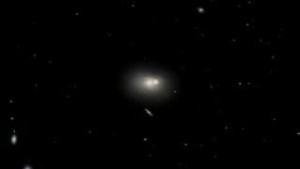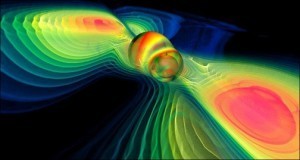This is an image of a black hole. Actually, the black hole is in the center and can’t be directly seen. What we see are two large jets streaming away from the black hole. When matter accretes around a black hole, some of it is captured, but some of it is pushed away into long jets. In the case of this image, the jets stream out for about 1.5 million light years. It’s known as Hercules A, and it’s one of the brightest radio galaxies.
The purple lobes in this image show radio emissions, not visible light. It was taken using the Very Large Array (VLA). Since the jets are made of plasma, they are bright at radio wavelengths, but not very bright at optical wavelengths. The supermassive black hole driving Hercules A is at the center of a rather bland elliptical galaxy known as 3C 348. The image above combines an image of the galaxy in the visible spectrum with the radio image of the lobes.
Since the VLA is an array of radio antennas, it can produce detailed radio images. We can see, for example how the jets stream out in a narrow beam at nearly the speed of light, eventually slowing and interacting to create wide turbulent lobes. By studying images such as this we can better understand how high energy plasma interacts in space.













Comments
OK. Those 1.5 million light year jets are the result of more matter than the 2.5 billion solar mass black hole could handle. Is this the result of a collision of galaxies?
I would rename this galaxy as the Whistling Teapot Galaxy